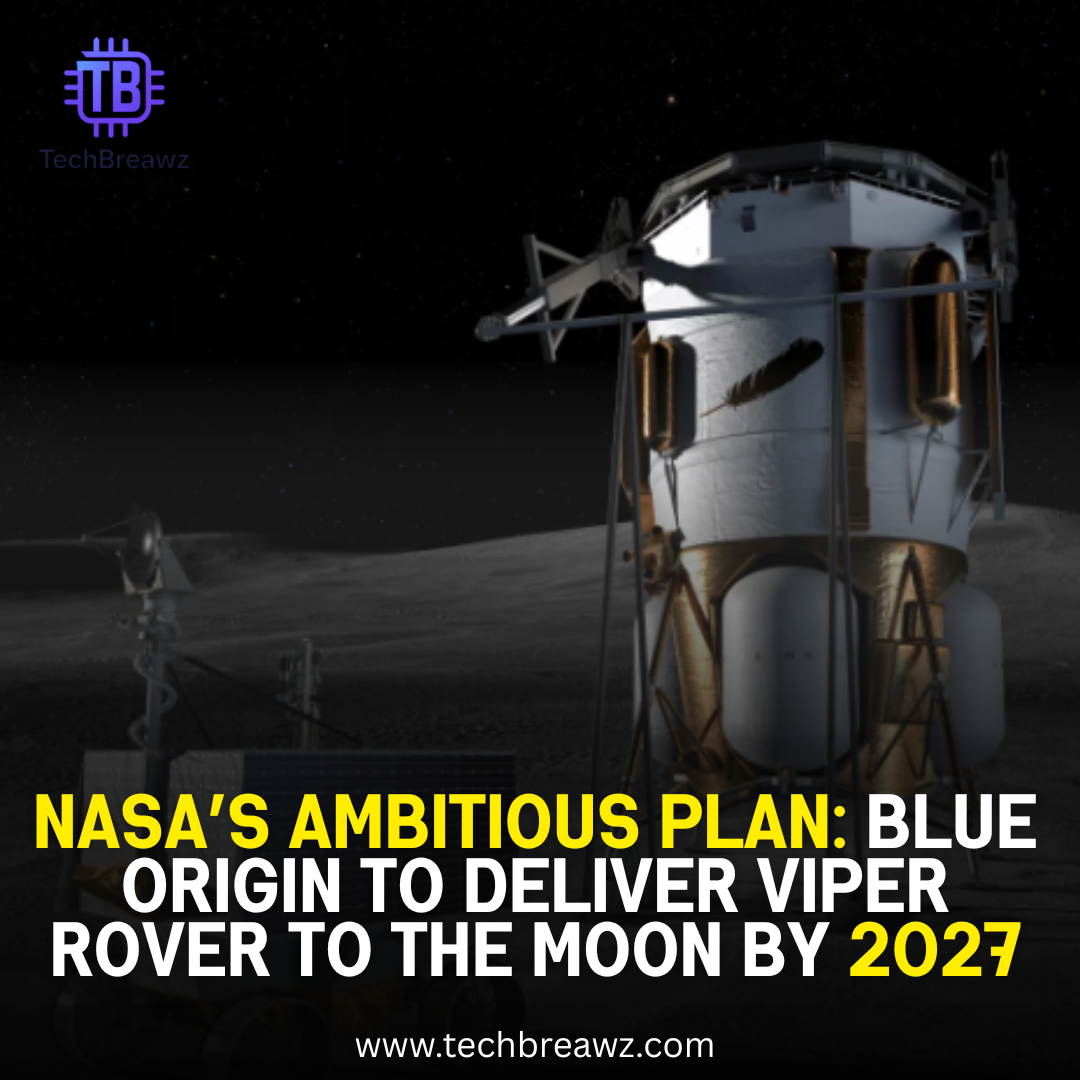NASA has made a bold decision to revive its VIPER mission by contracting Blue Origin to deliver the VIPER rover to the Moon’s south pole by late 2027. After being cancelled in 2024 due to cost overruns and schedule delays VIPER (Volatiles Investigating Polar Exploration Rover) is getting a second life under a public-private partnership. This move not only underscores NASA’s commitment to returning humans to the Moon under the Artemis program but also highlights new strategies in how lunar exploration missions are structured, funded, and carried out.
In this article, we’ll walk you through: what VIPER is, why it matters, how Blue Origin and its “Blue Moon” lander fit into the mission, what is expected scientifically, the implications for Artemis and future Moon and Mars missions, and finally some frequently asked questions.

What is the VIPER rover?
- Full name: Volatiles Investigating Polar Exploration Rover.
- Purpose: To search for volatiles (especially water ice) in the permanently shadowed regions of the Moon’s south pole, map their distribution, and assess how accessible they are.
- Science duration: Approximately 100 days of operations on the lunar surface.
- Instruments & tools: VIPER carries multiple instruments, including drills (like TRIDENT), spectrometers, etc., designed to detect and measure ice, soil composition, and other volatiles.
Before it’s cancellation it was to be delivered by Astor tic’s Griffin lander.
Why Was VIPER cancelled & what changed?
- In July 2024, NASA cancelled the VIPER project due to growing costs, schedule delays, and concern about its impact on other programs.
- The decision saved about US$84 million but raised concerns in the space science community about losing opportunities to map lunar volatiles.
- After cancellation, NASA explored alternate approaches, including proposals from private companies to deliver and operate the rover.
What Changed :
- NASA issued an “Announcement for Partnership Proposal” seeking U.S. companies to revive VIPER.
- On September 19, 2025, NASA officially awarded a contract (task order CS-7 through its Commercial Lunar Payload Services, CLPS, program) to Blue Origin to deliver VIPER using its Blue Moon Mark 1 (MK1) lander.
What is Blue origin’s role & the Blue moonMK1 Lander.
The CLPS task order: CS-7
- Value: Potentially US$190 million.
- Scope:
Design payload-specific accommodations.
Demonstrate how the Blue Moon MK1 lander will off-load VIPER safely.
Optionally deliver and deploy VIPER on the lunar surface. The decision to exercise this option depends on results from earlier phases including Blue Moon MK1’s first flight.
Blue Moon MK1 Lander
Manufacturer: Blue Origin.
Purpose: To carry payloads to the lunar surface, including VIPER
Status: In production as of this agreement. It is a second Mark-1 lander being prepared to carry VIPER.
| Milestone | Expected Time / Status |
| First Blue Moon MK1 lander flight (other payloads) | Later in 2025 (Blue Origin’s first CLPS delivery using MK1 to carry other instruments) (NASA) |
| Award of task order for VIPER delivery (CS-7) | September 2025 (NASA) |
| Design & analysis, payload accommodation work | Ongoing through 2025-2026 (NASA) |
| Decision to exercise delivery / deployment option | After demonstration and review of base task and Blue Moon MK1 first flight (NASA) |
| Targeted landing & VIPER deployment on Moon’s south pole | Late 2027 (NASA) |
Scientific Goals & Significance
Mapping lunar volatiles:
VIPER will explore permanently shadowed regions near the Moon’s south pole, where sunlight does not reach and where water ice may exist.
Supporting Artemis missions:
The data will help identify suitable landing sites for future crewed missions, contributing to sustainability in lunar exploration.
Resource utilization:
Water ice is not just scientifically interesting, but potentially usable—for drinking water, breathable oxygen, or fuel (via splitting into hydrogen and oxygen). Using local (in-situ) resources is key to reducing costs of long-term human presence.
Understanding lunar environment & evolution:
Studying volatiles helps understand solar system history, lunar geology, cometary impacts, and processes that deliver volatile materials.
Challenges & Risks
- Technical & schedule risk: Ensuring the Blue Moon MK1 lander and deployment mechanisms work reliably. Any delay could push mission beyond its science window.
- Cost control: This was a major reason why the mission was halted once. NASA is trying to do this cost-effectively via the CLPS mechanism.
- Working in the lunar environment: Permanently shadowed regions are extremely cold, and low to no sunlight means difficult thermal and power conditions. Systems must survive harsh terrain and darkness.
- Timing constraints: The 100-day science window hinges on landing by late 2027. Delays upstream (in design, integration, launch) could reduce or eliminate science returns.
Implications for NASA, Blue Origin, & the Future of Lunar Exploration
Public-Private Partnerships (PPP): This is a strong example of NASA relying on the private sector to deliver components of major exploration missions. CLPS is central to this.
American leadership in space: With Blue Origin, NASA can leverage U.S. industry to maintain leadership in lunar operations.
Artemis Program’s momentum: Artemis aims for sustainable lunar presence. VIPER’s data will feed into planning for human landings, lunar bases, and resource utilization.
Economics of space resources: If water ice is accessible, this could reduce cost of future missions (less to carry from Earth), potentially enabling in-situ resource utilization (ISRU) and longer missions on the Moon and, later, Mars.
FAQ”S:
Q1: What is the VIPER rover?
A1: VIPER (Volatiles Investigating Polar Exploration Rover) is a NASA lunar rover designed to explore the Moon’s south polar region and search for water ice and other valuable resources.
Q2: Why was VIPER cancelled in 2024?
A2: NASA cancelled the VIPER mission in July 2024 because of cost overruns and schedule delays that could have affected other space projects.
Q3: Who will now deliver the VIPER rover to the Moon?
A3: NASA has selected Blue Origin to deliver VIPER using its Blue Moon Mark-1 lander, with a target landing at the Moon’s south pole by late 2027.
Q4: What are the scientific goals of VIPER?
A4: VIPER will map and analyze lunar volatiles like water ice, explore permanently shadowed craters, and provide critical data for future human missions under the Artemis program.
Q5: What is CLPS in NASA missions?
A5: CLPS stands for Commercial Lunar Payload Services. It is NASA’s program to hire private U.S. companies to deliver science instruments and payloads to the Moon.
The revival of the VIPER rover mission via a deal with Blue Origin marks a pivotal moment in NASA’s lunar exploration strategy. It reflects not only a recommitment to science — specifically, the search for water ice, which has far-reaching implications for future human presence on the Moon and beyond — but also an evolution in how space missions are planned, integrating greater private-industry involvement for cost control and flexibility.
How to recover permanently deleted text messages a complete guide
If all goes to plan, VIPER’s 100-day expedition in the Moon’s shadowed south polar regions by late 2027 could unlock vital knowledge: where water ice is located, how accessible it is, and how to build future missions around these resources. For Artemis, for lunar colonization for Mars — VIPER is small but could be hugely impactful.
Source: NASA

